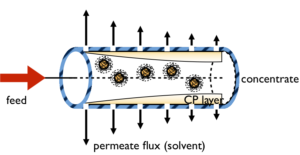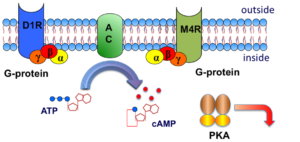Transport Phenomena
Transport and migration of (bio-) macromolecules play an important role in biological- as well as technological processes. We focus on the dynamics of charged macromolecules under equilibrium conditions, filtration processes, and a new project in which we plan to model the post synapse signal transduction cascade.
| Charged Colloids
Dispersions of charged colloids are ubiquitously occurring in bio-chemistry, medicine and pharmacy, and in many technological products. Using state-of-the art theoretical tools and simulations, and a variety of experimental methods, we study diffusion, rheology, electrokinetics, microstructure and phase behaviour of concentrated dispersions. The explored systems include suspensions of rigid synthetic particles [1, 2, 3], ionic micro gels [4], solutions of DNA fragments [5], as well as protein- [6, 7] and and electrolyte solutions [8]. Our aim is to understand these particulate systems on basis of their direct and hydrodynamic interactions [9, 10]. |
 Inter-particle interactions by electrostatics and hydrodynamics, mediated via the solvent in which the colloids are embedded. |
FiltrationPressure-driven membrane filtration is commonly used for the concentration, purification and separation of particulate systems such as protein solutions, microgel suspensions, milk and beer. A frequently applied technique is cross-flow filtration where the feed dispersion is continuously pumped through a parallel array of membrane pipes. We have developed a realistic model for the diffusion-advection transport of particles in cross-flow filtration, in collaboration with process engineers at the RWTH Aachen University (project B6 in SFB 985 on Functional Microgels). In this project, we bridge the gap from the theoretical exploration of intra-particle and concentrated dispersion transport properties [11] to the modelling of a technologically important filtration process [12, 13]. |
 A schematic of a pressure-driven membrane filtration set-up. The (microgel) particles are transported from left to right. A concentration-polarization (CP) layer is formed at the membrane during filtration. |
Post-synaptic Signal TransductionIn this new project in collaboration with INM-9, our aim is to develop a physical description of neural cascades for translational neuroscience, and here in particular of post-synaptic reward signal transduction important for reinforcement learning processes (see figure). |
 A schematic representation of the post-synaptic cascade, starting with the release of a G-protein upon binding of a receptor, which initiates a cascade of particle transport and chemical reactions. |
Self-Diffusion of RodsDispersions of colloidal viruses, in our case fd virus, display a cascade of phase transitions, from isotropic to the nematic [1], the smectic [2, 3] and the columnar [4] phase with increasing concentration. Uncovering the dynamics underlying these phase transitions, which is fundamental to understand the process of self-assembly, as it is purely driven by entropy. We use fluorescence video microscopy in order to study the self-diffusion of rods in the different phases. This study gave and still gives a wealth of surprising features, such as discretised Brownian diffusion in the smectic and large rods that diffuse faster than short rods. |
 Two viruses with different lengths, and with different fluorescent labeling, diffusing in a smectic phase of native fd-virus.
|
